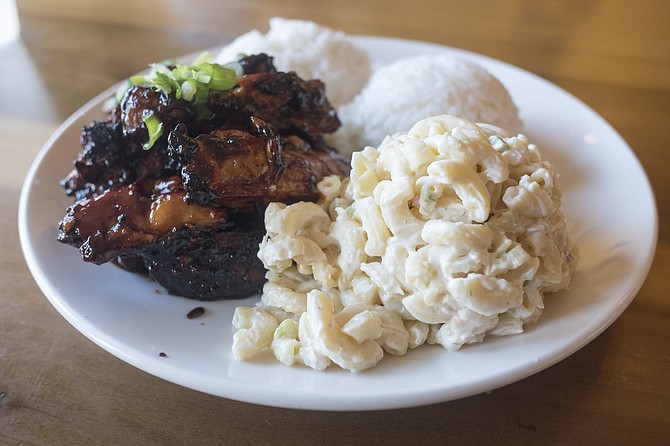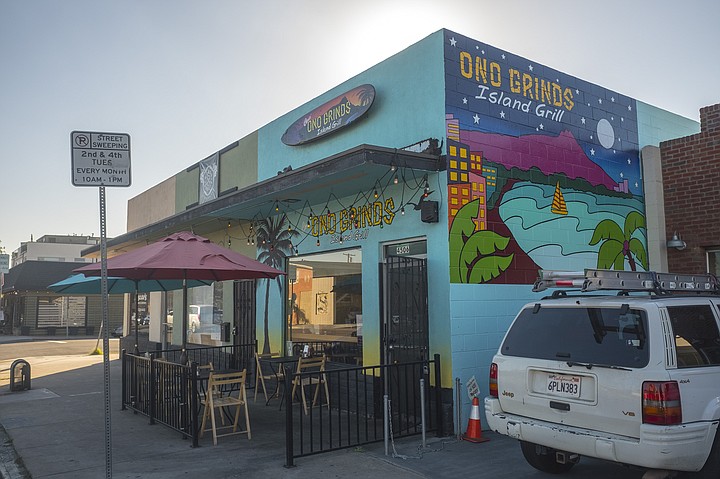 Facebook
Facebook
 X
X
 Instagram
Instagram
 TikTok
TikTok
 Youtube
Youtube

It's been a while since the aroma of food lured me into a restaurant. But, as I was passing through North Park, whatever was cooking at Chris' Ono Grinds Island Grill made me hungry enough to stop.
"What smells so delicious?" I asked the young woman behind the service counter.
She shrugged. "We make Hawaiian food."

If she wasn't impressed, I was gearing up to be. I scanned the menu board posted over the counter: ahi poke, kalua pig, loco moco. These were familiar Hawaiian dishes, but not responsible for the bouquet of grilled fowl that so enticed me.
"Huli huli chicken," I read aloud, "What's that?"
"It's like teriyaki," she said.
Her blasé comparison doesn't do huli huli justice. Teriyaki chicken is fine, but it's usually the last item I'd order off a Japanese menu. It's there to appeal to finicky eaters, to appease that member of the party who got dragged to the restaurant, and is too afraid to try raw fish, or foodie pleasures derived from fermented soy paste.
It's true enough that huli huli is Hawaiian cuisine's answer to teriyaki. A little research suggests the grilled chicken dish has been a staple of roadside stands since the 50s or 60s, and the guy who first put this islander twist on teriyaki bottled his sauce and trademarked the name huli huli (which translates to turn turn, because the chicken cooks on both sides).
Both marinades employ a ginger, brown sugar, and soy sauce base. But whereas teriyaki adds rice wine, Ono Grind's house-made huli huli incorporates sherry, sesame oil, honey, and ketchup.
It sounds ludicrous to suggest ketchup elevates teriyaki's flavor, so officially I'm going to suggest the sherry and sesame oil are responsible my liking huli huli better. However, as teenagers living on military bases in Japan, my friends and I did often pour teriyaki on pizza, so maybe it's the combination of tomato and ginger that I really find so alluring.
Despite any similarities in flavor, the standard Hawaiian plate lunch, where a pile of meat is served with ice-cream-scooped portions of white rice and macaroni salad, is about as far removed as one gets from the practiced elegance of Japanese presentation. So if I sound jaded about teriyaki's place on a sushi restaurant menu, I'm equally as enthusiastic to find its counterpart at Ono Grinds, on an unceremonious $11 plate.
The grilled chunks of marinated chicken breast lived up to the siren smells that brought me in off the street. Charred edges contributed smoky savor to balance a sauce that would normally prove too cloying for my palate. By the end of the meal, the sweetness did start to push my tolerance. But there's an umami beneath the brown sugar and honey that held me satisfied in between the white rice and the mayo of that mac salad.


It's been a while since the aroma of food lured me into a restaurant. But, as I was passing through North Park, whatever was cooking at Chris' Ono Grinds Island Grill made me hungry enough to stop.
"What smells so delicious?" I asked the young woman behind the service counter.
She shrugged. "We make Hawaiian food."

If she wasn't impressed, I was gearing up to be. I scanned the menu board posted over the counter: ahi poke, kalua pig, loco moco. These were familiar Hawaiian dishes, but not responsible for the bouquet of grilled fowl that so enticed me.
"Huli huli chicken," I read aloud, "What's that?"
"It's like teriyaki," she said.
Her blasé comparison doesn't do huli huli justice. Teriyaki chicken is fine, but it's usually the last item I'd order off a Japanese menu. It's there to appeal to finicky eaters, to appease that member of the party who got dragged to the restaurant, and is too afraid to try raw fish, or foodie pleasures derived from fermented soy paste.
It's true enough that huli huli is Hawaiian cuisine's answer to teriyaki. A little research suggests the grilled chicken dish has been a staple of roadside stands since the 50s or 60s, and the guy who first put this islander twist on teriyaki bottled his sauce and trademarked the name huli huli (which translates to turn turn, because the chicken cooks on both sides).
Both marinades employ a ginger, brown sugar, and soy sauce base. But whereas teriyaki adds rice wine, Ono Grind's house-made huli huli incorporates sherry, sesame oil, honey, and ketchup.
It sounds ludicrous to suggest ketchup elevates teriyaki's flavor, so officially I'm going to suggest the sherry and sesame oil are responsible my liking huli huli better. However, as teenagers living on military bases in Japan, my friends and I did often pour teriyaki on pizza, so maybe it's the combination of tomato and ginger that I really find so alluring.
Despite any similarities in flavor, the standard Hawaiian plate lunch, where a pile of meat is served with ice-cream-scooped portions of white rice and macaroni salad, is about as far removed as one gets from the practiced elegance of Japanese presentation. So if I sound jaded about teriyaki's place on a sushi restaurant menu, I'm equally as enthusiastic to find its counterpart at Ono Grinds, on an unceremonious $11 plate.
The grilled chunks of marinated chicken breast lived up to the siren smells that brought me in off the street. Charred edges contributed smoky savor to balance a sauce that would normally prove too cloying for my palate. By the end of the meal, the sweetness did start to push my tolerance. But there's an umami beneath the brown sugar and honey that held me satisfied in between the white rice and the mayo of that mac salad.
Comments